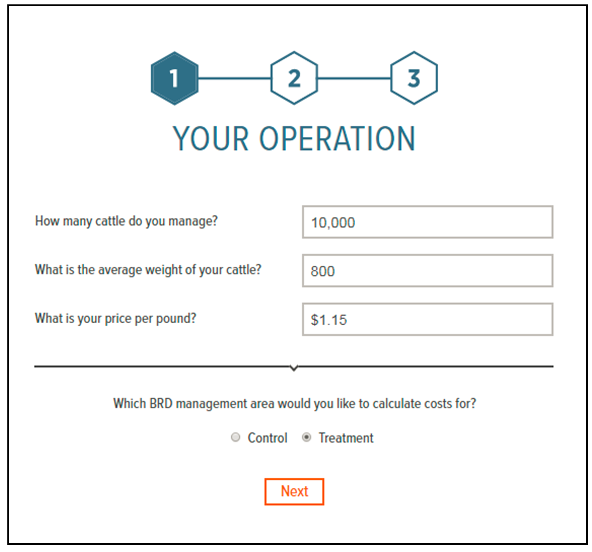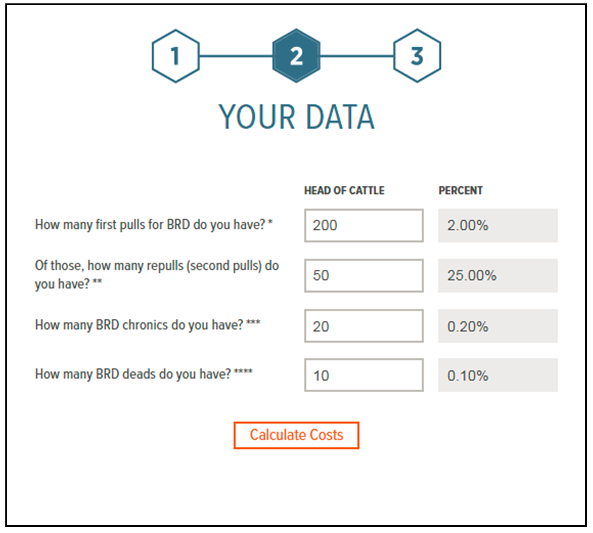



Calculate how much BRD is costing you in 3 easy steps
For a quick measure of what BRD could cost, and how to minimize these costs, input data into this new toolYou might have heard bovine respiratory disease (BRD), or shipping fever, can cost up to $240 per head just considering performance losses.[1-3] You know BRD is costly, but do you know what it actually could be costing you?
On the surface, it’s clear what BRD might be costing in medication costs. But, there are additional costs — labor, re-treatment costs, chronics, deaths and loss in performance — that aren’t as easy to see and need to be factored into the equation as well.
A new BRD Cost Calculator from Zoetis at BRD-Solutions.com can help you estimate all your operational costs — and potential economic losses — from BRD. And it’s as easy as 1-2-3 to get your results.
Step 1: Enter information about your operation.
The more you know about what you’re facing, the better equipped you’ll be to make informed decisions that can help maximize cattle health and productivity on your operation. The calculator allows you to enter information that’s specific to your operation and cattle, including weight and price per pound, and calculate costs for BRD control and treatment.
Step 2: Enter information about your current BRD management program.
Annually, there are approximately $1 billion in feedlot losses due to BRD.[4,5] These costs include loss of production, increased labor expenses, medication costs and death.
So, in addition to first-treatment medication costs, the calculator also helps consider other costs from BRD. An example of data needed to help calculate costs of treating BRD is at right. The calculator assumes national averages for medication costs, labor time and wages, and performance and death losses, so you receive a midrange estimate of your total potential economic losses from BRD.
Step 3: Get results to help you better manage BRD and minimize economic losses.
When you get your results, you can see the expenses that come with managing BRD on your operation, including medication, labor, re-treatment costs, chronics, deads and performance losses, can add up. Unmanaged BRD comes at a huge cost, but it could cost your operation less if you choose the right antibiotic first. For example, choosing DRAXXIN® (tulathromycin) Injectable Solution for control or treatment of BRD, with superior first-use efficacy and better treatment success, can help eliminate secondary costs of extra hours for your employees in re-treatment time, more re-treatment medication costs, increased chronics and cattle deaths and more instances of prolonged cases of BRD that can significantly impact the performance and weight of your cattle. A less effective antibiotic can result in more of these secondary costs and result in costs greater than your first-treatment medication costs.
To help compare different antimicrobials for BRD control and treatment and find what’s best for your operation, you’ll receive a handy chart with your results to discuss with your veterinarian. Visit BRD-Solutions.com to try out the BRD Cost Calculator and find more information to help better manage BRD.
IMPORTANT SAFETY INFORMATION FOR DRAXXIN: DRAXXIN has a pre-slaughter withdrawal time of 18 days in cattle. Do not use in female dairy cattle 20 months of age or older. Do not use in animals known to be hypersensitive to the product. See full Prescribing Information.
About Zoetis
Zoetis is the leading animal health company, dedicated to supporting its customers and their businesses. Building on more than 60 years of experience in animal health, Zoetis discovers, develops, manufactures and markets veterinary vaccines and medicines, complemented by diagnostic products, genetic tests, biodevices and a range of services. Zoetis serves veterinarians, livestock producers and people who raise and care for farm and companion animals with sales of its products in more than 100 countries. In 2016, the company generated annual revenue of $4.9 billion with approximately 9,000 employees. For more information, visit www.zoetisUS.com.
[1] Griffin D. Economic impact associated with respiratory disease in beef cattle. Vet Clin North Am Food Anim Pract. 1997;13(3):367-377
[2] Hicks B. Impact of Morbidity on Performance and Profitability of Feedlot Cattle. Beef Cattle Research Update. Oklahoma State University. Panhandle Research and Extension Center. May 2006:1-2
[3] Grubbs ST, Kania SA, Potgieter LND. Prevelence of ovine and bovine respiratory syncytial virus infection in cattle determined with a synthetic peptide-based immunoassay. J Vet Diagn Invest. 2001;13(2):128-132.
[4] Brodersen BW. Bovine respiratory syncytial virus. Vet Clin North Am Food Animal Pract. 2010;26(2):323-333
[5] Griffin Dr, Chengappa MM, Kuszak J, McVey DS. Bacterial pathogens of the bovine respiratory disease complex. Vet Clin Notrh Am Food Anim Pract. 2010;26(2):381-396
| TheCattleSite News Desk | Read more Zoetis News here |






